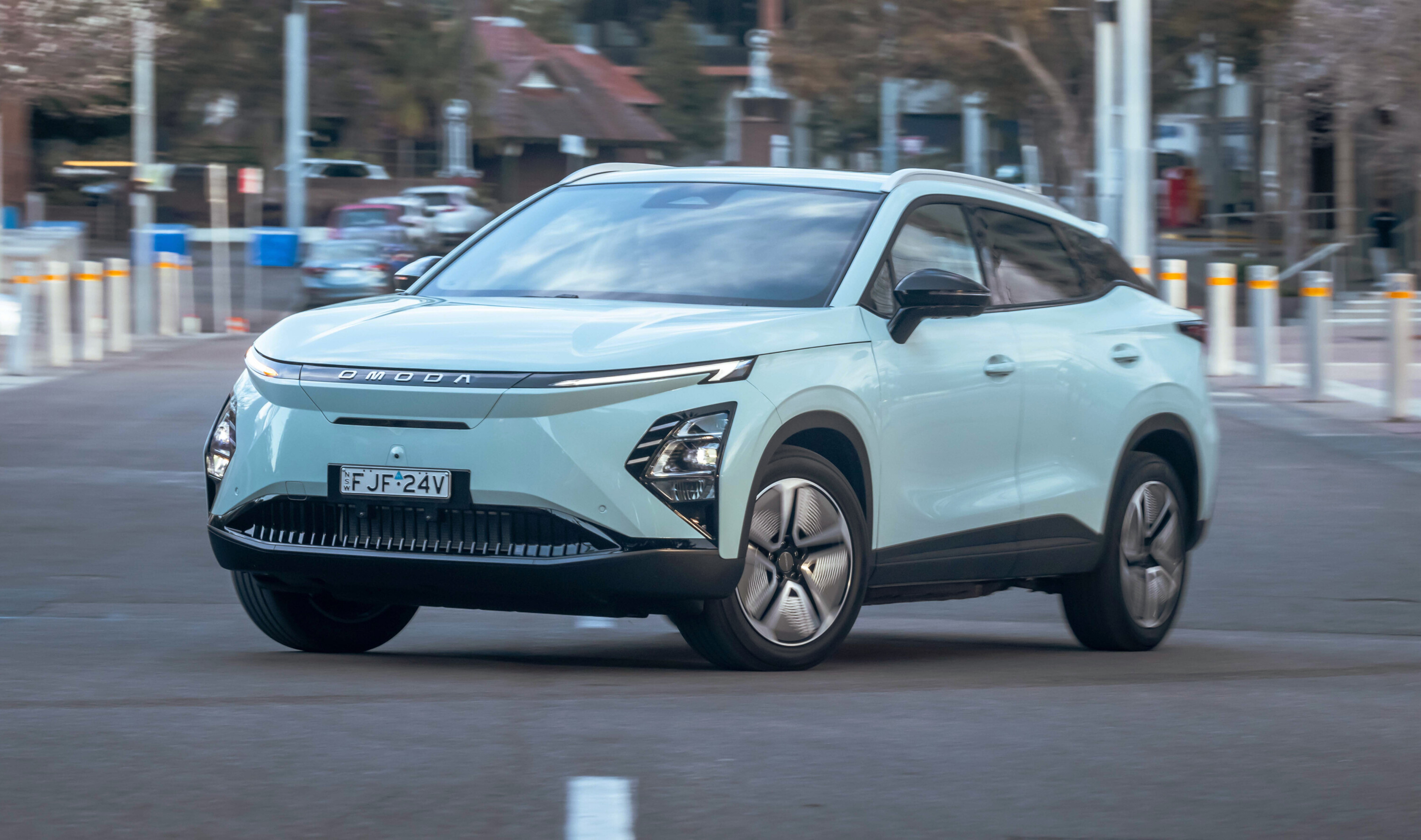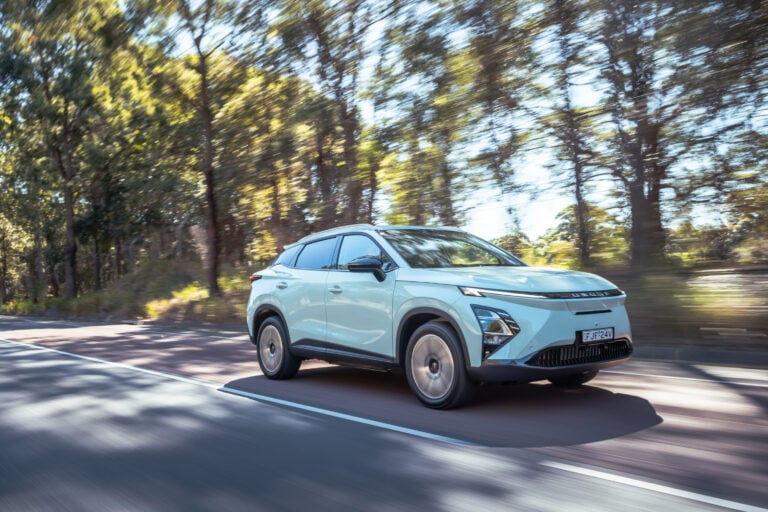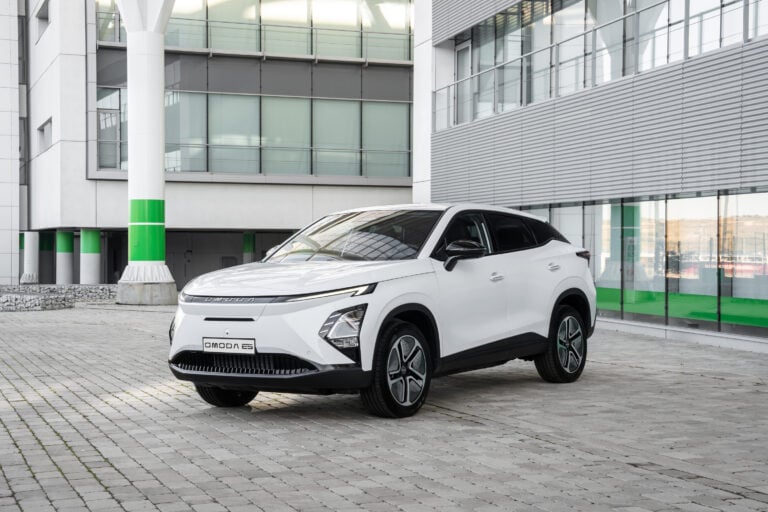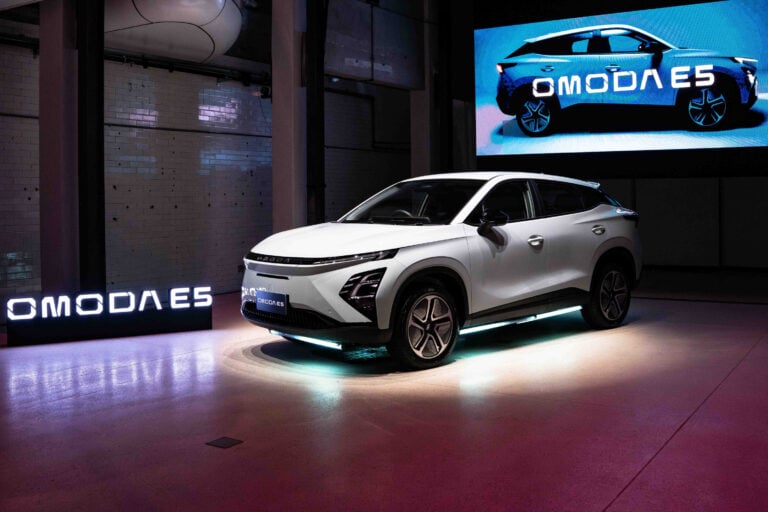
Score breakdown
Things we like
- EV gets specific smarter styling
- Value for money
- Driving range
Not so much
- Base car’s cheap steering wheel
- Intrusive driver assist systems
- Unresolved driving dynamics
Chery has been the largest exporter of cars from China for the past 21 years – yet the 2024 Omoda E5 five-seat SUV is the brand’s first electric car in Australian showrooms since it returned in early 2023.
The Omoda E5 – ‘E’ for ‘electric’ of course – uses the same ‘T1X’ underpinnings as the car maker’s best-selling model in Australia, the Omoda 5 SUV, but adds electric power, retuned chassis and unique styling inside and out. That means you won’t mistake the electric Omoda for its petrol sibling in the car park, with 50mm additional length (4424mm) – although it has an identical wheelbase, tracks, overall width and height.
JUMP AHEAD
What you get
The Omoda E5 starts at $42,990 plus on-roads – where the petrol Omoda 5 kicks off at $27,990 driveaway – making it more than the similarly sized MG ZS EV but undercutting the entry-level BYD Atto 3 electric SUV’s $44,449.
That gets the entry-level BX – the first of two trim levels – including 18-inch alloy wheels, dual 12.3-inch screens and wireless smartphone connectivity as standard. There’s also seven airbags – including a front centre airbag – as standard, and while an ANCAP test is yet to take place, AEB, Adaptive Cruise Control with Traffic Jam Assist, Lane Departure Prevention and Rear Cross Traffic Braking are fitted across the line-up.

The higher spec Omoda E5 EX adds a gloss-black exterior beltline, synthetic leather trim, a 360-degree camera, upgraded audio, powered tailgate and sunroof for $45,990.
Both use the same 150kW/340Nm single electric motor sending drive to the front wheels with a 61.1kWh lithium-iron phosphate battery and WLTP range of 430km – 10km more than the Atto 3 Standard Range – and 155kWh/km consumption.
We didn’t get near testing those broader capabilities on our brief introductory drive around the Australian Capital Territory (ACT) mainly on highway roads.
Interior
In the driver’s seat, the dual 12.3-inch screens – larger than the petrol version’s 10.25-inch displays – dominate the cabin, which has been given a premium push as the Omoda 5 line-up’s new flagship, with no physical knobs or switches beyond the steering wheel-mounted controls.
Only the steering wheel and seats carry over from the petrol Omoda 5 and the overall fit and finish is good with little separating BX and EX trim levels, with the same centre console gloss ‘woodgrain’ and piano black inserts on both.

The base model’s horrible plastic steering wheel is ditched from a much nicer synthetic leather wheel on the higher spec, which also covers the seats instead of the base car’s black cloth. Those seats are quite supportive and the driving position good – although there could be more seat adjustment, especially on the base car which has manual levers against the BX’s electric front row.
Once set, there’s a decent sized side centre mirror which you’ll need as the view out of the rear windscreen is narrow – interrupted by the three rear head restraints – with the smaller side mirrors adequate but seemingly tuned more towards extending range rather than vision.
The cabin is spacious up front while at the rear there’s 60/40 split-fold seats, slightly more cargo space – 1079L – than the petrol model and includes a full-size spare wheel. There’s also additional 19L cargo space under the bonnet in the E5’s front trunk.

On-road performance
There’s no ‘Start’ button – instead a ‘Ready’ status once the proximity key is detected and a driver behind the wheel – with Eco, Normal and Sport drive modes to choose from.
Acceleration is strong – the 6.7-second 0-100km/h claim entirely believable – but there’s a lot of nose lift and torquesteer as the unwieldy front-end and vague steering combine to have you working to keep the vehicle in a straight line under heavy throttle.
Being gentle is the key, but even in the Normal drive mode and the lowest of three brake regeneration settings, seemingly minor accelerator pedal lift brings over-zealous recoil, demanding constant footwork.

The suspension tune developed by Chery Europe has undergone further local testing, but perhaps only underlines how bad Australian roads are as the 18-inch alloys fitted on all models managed to bring small bumps and ruts into the cabin we didn’t even see coming.
Yet the E5 was slow to settle over high-speed corrugations, with the softness also serving up a large amount of body roll – not overly well controlled – around roundabouts and longer corners for the 1776kg SUV, while in a straight line there was plenty of road noise.
Our sample drive was not enough to reveal a significant difference between the three drive modes, which alter steering and throttle behaviour. It was enough to be interrupted by the highly-strung fatigue warning after only a short distance – while some test cars in our group had an insufferably loud indicator chime which thankfully can be turned off.

VERDICT
With a seven-year unlimited warranty – eight on the battery – the Omoda E5 is a strong on-paper contender, but its lack of polish behind the wheel makes it less convincing in the metal.
However, for many buyers, its value alone will be more than enough to overcome its shortcomings.
| 2024 Chery Omoda E5 EX specifications | |
|---|---|
| Price | $42,990 plus on-road costs |
| Electric motors | One permanent magnet synchronous |
| Battery | 61.1kWh lithium-ion-phosphate |
| Drive | Front-wheel drive |
| System power | 150kW |
| System torque | 340Nm |
| Transmission | 1-speed reduction |
| L/W/H | 4424/1830/1588mm |
| Wheelbase | 2610mm |
| Track(f/r) | 1550/1550mm |
| Weight | 1776kg |
| Boot | 380 litres + 19L front |
| Range | 430km (WLTP) |
| Efficiency | 155kWh/100km (claimed) |
| Suspension front | Struts, coil springs, anti-roll bar |
| Suspension rear | Multi-links, coil springs, anti-roll bar |
| Steering | Electric power-assisted |
| Front brakes | Ventilated disc (306mm) |
| Rear brakes | Solid disc (311mm) |
| Tyres | Kumho Ecsta PS71 |
| Tyre size | 215/55R18 (f/r) |
| ANCAP | Unrated |
| 0-100km/h | 6.7sec (claimed) |
Score breakdown
Things we like
- EV gets specific smarter styling
- Value for money
- Driving range
Not so much
- Base car’s cheap steering wheel
- Intrusive driver assist systems
- Unresolved driving dynamics
We recommend
-
 News
News2024 Chery Omoda E5: Pricing confirmed
All-electric crossover SUV lands with a sub-$50k price tag
-
 News
News2024 Chery Omoda E5: Specifications confirmed
Chery Australia has confirmed the specs for its all-electric E5
-
 News
News2024 Chery Omoda E5: electric SUV unlikely to undercut BYD Atto 3's price
All-electric version of Chery Omoda 5 small SUV due in Australia in mid-2024



